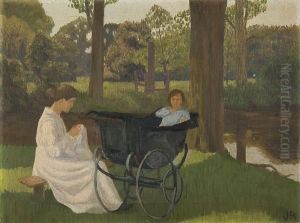Jacques Pierre Raverat Paintings
Jacques Pierre Raverat, born in 1885, was a French painter and wood engraver who became an integral part of the early 20th-century British art scene. His work is often associated with the Neo-Impressionist movement, although his style evolved significantly over his relatively short career. Raverat's contribution to art is marked by his innovative approach to wood engraving and his ability to blend traditional techniques with modernist aesthetics.
Raverat's early life in France provided him with a solid foundation in the arts, leading him to pursue further education at Cambridge University, where he became a member of the intellectual circle known as the Bloomsbury Group. This association placed him at the heart of British modernism, allowing him to form close ties with key figures such as Virginia Woolf and John Maynard Keynes. His marriage to the painter Gwen Darwin, a member of the prominent Darwin-Wedgwood family, further cemented his place within Britain's cultural elite.
Throughout his career, Raverat was deeply influenced by the changing artistic movements of his time, yet he maintained a distinctive voice. His landscapes and figurative works reveal a keen sensitivity to light and form, characteristics that aligned him with Neo-Impressionist artists. However, it was his mastery of wood engraving that truly set him apart. Raverat adapted this traditional medium to express modernist themes, blending classical and contemporary elements in works that were both innovative and deeply reflective of his personal experiences.
Tragically, Raverat's life and career were cut short when he died in 1925 at the age of 40. Despite his early death, Raverat left behind a significant body of work that continues to be celebrated for its originality and influence on British modernism. His legacy is preserved through collections in major galleries and through the continued study of his techniques and artistic philosophy. Raverat's unique approach to art, marked by a blend of tradition and modernity, remains a significant contribution to the history of Western art.
